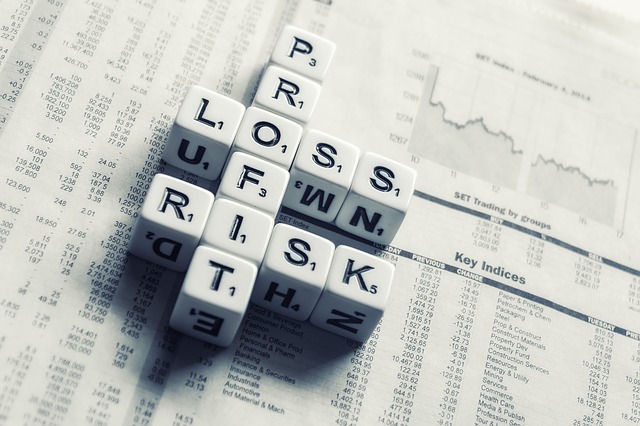Risk is one of the most important concepts in investing, economics, and personal finance. Our appetite for, or aversion to, risk is the biggest driver behind spend and save decisions. Despite this, very few people really understand just how big a role risk plays in our everyday lives.
Risk Definition
“Risk” is the probability for an event to not go the way we hope. Every event in the future, and every event we plan for has at least two outcomes: the way (or ways) we hope it goes, and the way (or ways) it could go wrong. There are two types of risks – the kind where we know the likelihood of failure, and the kind where we do not.
Well-Defined Risk

A dice roll is a well-defined risk – each side has an exactly 1/6 chance of rolling up
If a risk is “well-defined”, then we can usually find an exact probability of things turning out well, or things failing. Investing in a bond is one example of this – there are tons of investment research firms that publish risk assessments of a bond being paid back in full and on time.
This is usually expressed as a percentage or ratio of success vs failure. For example, a US Treasury Bond has a 99% chance of paying itself back on time, and less than 1% risk of default.
Poorly Defined Risk
A risk is “poorly-defined” if we do not have access to all this research – when we are making wild guesses at the chance of failure. Most researchers start by assuming any event has a 50% chance of failure, then update that estimate as more information is added.
Nearly all risk starts as “poorly defined”, but research into other past events helps us clear the mystery. For example, if you have never heard of a company trading on the stock market, you would have no idea if it would make a good investment or not (a 50% chance of success, and a 50% chance of failure).
You could start your research by looking at the company’s history – if they have been in business for a long time with steady profits, it would reduce the risk of failure. If it looks like they just started listing their stock yesterday with no real profits yet, it would increase the risk of failure.
Risk and Interest Rates
If someone needs to borrow money, their lender would consider the “risk” of that loan being paid back when determining the interest rate.
For example, a bank may have a 3% baseline interest rate – they want to earn a 3% rate of return on any loans they issue. Every time a borrower asks them for a loan, they will do research into this person’s income and credit history to get a picture of how much risk there is for the loan.
Calculating Interest Rate with Risk – Expected Value
 Imagine a borrower wants to borrow $1,000 from the bank for a 1-year loan. The bank starts with their baseline interest rate of 3% – they want to make sure that they can expect $1030.00 at the end of the year.
Imagine a borrower wants to borrow $1,000 from the bank for a 1-year loan. The bank starts with their baseline interest rate of 3% – they want to make sure that they can expect $1030.00 at the end of the year.
After doing their research, they estimate that the borrower has a 10% risk of failing to make the payments (a Well-Defined risk). If he fails to make all the payments, they do not know how much they will get back (a Poorly-Defined risk). Since this is a poorly defined risk, they will assume they will get half their money back if he fails at some point.
To calculate the interest rate they plan on charging, they want to make sure the expected value of the loan is $1,030.00 – the same as it would be if there was no risk. To calculate the expected values, they will assign the probabilities to each outcome – 90% he pays in full, 10% that he fails. They will then pick an interest rate that will make the expected value equal to the $1030.00 that they want to finish with the loan.
((Probability of paying back the loan X Full Payment) + (Probability of not paying back the loan X Partial Payment)) X (Interest Rate + 1) = $1030.00
((90% X $1030.00) + (10% x $515.00)) X (Interest Rate + 1) = $1030.00
($927.00 + $51.50) X (Interest Rate + 1) = $1030.00
$978.50 X (Interest Rate + 1) = $1030.00
Interest Rate + 1 = 1.0526
Interest Rate = 5.26%
At the 5.26% interest rate, the bank will get $1052.60 if the borrow pays back the full loan. The extra amount that they get beyond their original 3% is what they charge to cover the risk of the loan.
Risk and Psychology
A person’s appetite for risk will greatly change how they behave when faced with uncertainty. People try to minimize the amount of risk they need to manage, and will prefer a “sure thing” to balancing an expected value.
Risk Aversion
This leads to the idea of “Risk Aversion”. For example, imagine a coin toss game: heads, you get $100, tails you get $0, or you can just take $50 without flipping the coin at all. Most people would take the $50, because the cash-in-hand is better than the risk of 0. If you think you would still go for the coin flip and hope for the $100, we can just move around the starting positions: you can bet $50 of your own money to play. The expected value of all 3 choices is the same (you end with 0 for a tails, $100 for a heads, or $50 by walking away), but most people “feel” like it is a completely different game.
There is a practical application to this too – less risk makes it easier to plan. In the example of the bank trying to determine the interest rate, most banks will actually “round up” the interest to 5.5%, just to compensate the fact that they are taking a risk at all. As the size of the loan grows, so would be the “pain” in the even of a loss – this means bigger loans will often have higher interest rates, even with the same level of risk.
Risk Appetite
 Different people have different levels of risk aversion, and this will change as we change what is at stake. In our coin toss example, we can lower the stakes: heads you get $1, or you can take 50 cents without a toss. In this case, a lot more people would take the bet on the coin toss, since the risk involved is quite small.
Different people have different levels of risk aversion, and this will change as we change what is at stake. In our coin toss example, we can lower the stakes: heads you get $1, or you can take 50 cents without a toss. In this case, a lot more people would take the bet on the coin toss, since the risk involved is quite small.
Compare this to much higher stakes – what if $1 million was on the line for a coin flip, or $500,000 for free? Very few people would take the flip – even though $1 million is twice the reward, losing the $500,000 represents a much bigger risk.
A person’s appetite for risk will also determine what kinds of investments they will make. A person who has a much higher risk tolerance will shoot for volatile stocks that have a lot of price movement – trying to maximize their return. Someone with a lower risk tolerance is more likely to invest in big blue-chip stocks and bonds – not much of a return for price, but looking for a steady stream of dividends and interest payments.
Problems in Risk Assessment
This does present a problem for some investors – people are generally bad at assessing risk. It can be hard and time-consuming to fully research the pros and cons of one investment over another.
When looking at the spending patterns of large groups of people, we see that people tend to over-estimate the probability of unlikely events, mostly because the rare occurrences get a lot of attention. A perfect example of this is the lottery – the expected value of a lottery ticket (the % chance of winning times the amount you would win) is much lower than the price of the ticket, so a savvy investor would never buy a ticket. However, lottery winners get a lot of media attention, so there is a constant reminder that “YOU COULD BE NEXT!”. This brings emotion into the equation – encouraging participation and disregarding some of the risk.
Reducing Risk
A key skill in personal finance and economics is understanding how to reduce risk, and “lock in” more real returns. The two ways people and businesses reduce their risk is through diversification and insurance.
Diversification
Diversification means spreading out investments and assets. An investor would do this buy picking stocks in different industries, like a mix between agricultural, healthcare, and technology stocks. A business does this by opening separate brands or product lines – Coca-Cola (KO) also produces Dasani water, Minute-Maid fruit juices, and Vitamin Water to diversify its product line.
Diversification works because while different stocks might have the same level of risk, the triggers that would cause a loss are not likely to happen at the same time. If there is a drought, for example, agriculture stocks might lose money, but this would represent a smaller fraction of a portfolio, limiting the loss.
Insurance
Risk can be addressed directly by buying insurance. Insurance works the same as the banker deciding the interest rate for a loan.
Every time you buy an insurance policy, the insurance company starts by assessing how much loss you might face, and what the probability would be of that loss happening. The premiums charged by insurance companies have 2 parts:
- The percentage of profit they want to make on all policies (for the bank, this would be the 3% profit they aim for on all loans)
- Enough of a premium so the expected loss from filing a claim is 0.
For example, imagine you want to buy a $100,000 life insurance policy. Your insurance company targets a 5% profit on all policies, and they estimate that each year, you have a 2% chance of dying unexpectedly. They would set your premiums to make the expected value of paying out the policy zero, plus a 5% return on investment.
Annual premium = (Probability of having to pay out X Amount to pay out) X (Return on investment + 1)
Annual premium = (2% X $100,000) X (5% + 1)
Annual Premium = $2,000 X 1.05
Annual Premium = $2,100
This lesson is part of the PersonalFinanceLab curriculum library. Schools with a PersonalFinanceLab.com site license can get this lesson, plus our full library of 300 others, along with our budgeting game, stock game, and automatically-graded assessments for their classroom - complete with LMS integration and rostering support!
Get PersonalFinanceLab
[qsm quiz=180]

 Teacher Introduction Webinars
Teacher Introduction Webinars Investing in Romania
Investing in Romania State Financial Literacy Standards Alignment (December, 2023)
State Financial Literacy Standards Alignment (December, 2023) Exchange Offer
Exchange Offer